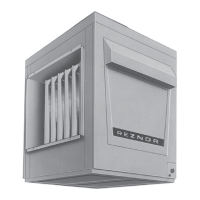Form I-X, P/N 150491 R7, Page 9
6.1.2 Manifold or
Orice Pressure
Settings
Measuring manifold gas pressure cannot be done until the heater is in operation. It is
included in the steps of the "Check-Test-Start" procedure in Paragraph 9.0. The follow-
ing warnings and instructions apply.
WARNING: Manifold gas pressure must never exceed 3.5" w.c. for
natural gas and 10" w.c. for propane gas.
For Natural Gas: When the heater leaves the factory, the combination valve is set so
that the outlet gas pressure of a single-stage valve or high re of a two-stage valve
is regulated to 3.5" w.c. Low re on a two-stage valve is set to 1.8" w.c. Inlet supply
pressure to the valve must be a minimum of 5" w.c. or as noted on the rating plate
and a maximum of 14" w.c. NOTE: Always check the rating plate for minimum gas
supply pressure. Minimum supply pressure requirements vary based on the size of
the burner and the gas control option. Most units require a minimum of 5" w.c. of natu-
ral gas as stated above, but Sizes 350 and 400 with electronic modulation require a
minimum of 6" w.c. natural gas supply pressure. Sizes 300 and 350 with mechanical
modulation require 7" w.c.
For Propane: When the heater leaves the factory, the combination valve is set so that
the outlet gas pressure of a single-stage valve or high re of a two-stage valve is 10"
w.c. Low re on a two-stage valve is set to 5" w.c. Inlet pressure to the valve must be
a minimum of 11" w.c. and a maximum of 14" w.c.
Before attempting to measure or adjust manifold gas pressure, the inlet (supply) pres-
sure must be within the specied range for the gas being used both when the heater is
in operation and on standby. Incorrect inlet pressure could cause excessive manifold
gas pressure immediately or at some future time.
Instructions to Check Manifold Pressure
:
1) With the manual valve (on the combination valve) positioned to prevent ow to the
main burners, connect a manometer to the 1/8" pipe outlet pressure tap in the valve.
NOTE: A manometer (uid-lled gauge) is recommended rather than a spring type
gauge due to the difculty of maintaining calibration of a spring type gauge.
2) Open the valve and operate the heater. Measure the gas pressure to the manifold. To
measure the low stage pressure on units equipped with a two-stage valve, disconnect
the wire from the "HI" terminal on the valve. (Be sure to reconnect wire.)
Normally adjustments should not be necessary to the factory preset regulator. If adjust-
ment is necessary, set pressure to correct settings by turning the regulator screw IN
(clockwise) to increase pressure. Turn regulator screw OUT (counterclockwise) to
decrease pressure.
CAUTION: DO NOT
bottom out the gas
valve regulator
adjusting screw.
This can result
in unregulated
manifold pressure
causing excess
overre and heat
exchanger failure.
Consult the valve manufacturer's literature provided for more detailed information.
6.2 Venting
DANGER: Failure to provide proper venting could result in death, serious injury, and/or
property damage. This furnace must be installed with a vent connection and proper vent to
the outside of the building. Install vent in accordance with Part 7, Venting of Equipment, of
the National Fuel Gas Code, ANSI Z223.1 (latest edition) or applicable provision of national,
state or local codes. A Canadian installation must be in accordance with the CSA B149.1
and B149.2, Installation Code for Gas Burning Appliances and Equipment, and applicable
local codes. Also, comply with venting requirements in this Paragraph.
Safe operation of any gravity-vented gas-red equipment requires a properly operating vent
system, correct provision for the combustion air (See Paragraph 2.2) and regular mainte-
nance and inspection. See Hazard Levels, page 2.
6.2.1 Venting
Requirements
1. Provide a minimum clearance of 18" between the drafthood relief opening and any
obstruction. Do not expose the relief opening to wind drafts from any source such
as from an overhead door or adjacent air handling equipment.

